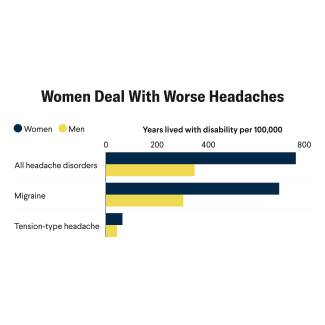This article includes a discussion of suicide. If you or someone you know needs help in the United States, call the national suicide and crisis lifeline at 988 or text the Crisis Text Line at 741741.
Artificial intelligence (AI) is embedding into the health sector, and mental health is no exception. Interpretable AI tools are increasingly being explored in clinical environments to enhance mental health care. These tools, often leveraging interpretable machine learning (IML), aim to improve decision-making by analyzing patient data to identify risks and prioritize care, supporting more efficient and targeted interventions.
Each year, more than 720,000 people die worldwide by suicide, and the true toll could be higher due to underreporting in places such as sub-Saharan Africa and South Asia. In the United States, suicide is the second leading cause of death for individuals age 10 to 34. From 2002 to 2022, suicide rates increased by 16%, with approximately 49,369 deaths reported in 2022. Non-Hispanic American Indian and Alaska Native populations have suicide rates nearly double the national average, signaling significant disparities in access to culturally appropriate mental health services. These alarming figures reflect persistent shortcomings in early intervention and equitable access to mental health care.
Machine learning tools can already assist in diagnosing cancer, cardiac anomalies, and brain disorders from imaging data. Psychiatry programs, such as the Department of Veterans Affairs' REACH VET, identify individuals at high risk of suicide using electronic health record data. A recent NIMH-supported study found the program led to a statistically significant reduction in suicide attempts, though its impact on overall suicide deaths remains under evaluation. Although promising, AI tools continue to raise skepticism, particularly when they rely on opaque black box models—or algorithms that make predictions without revealing how inputs lead to certain outputs. The risk of clinicians or patients not understanding how risk scores are generated could potentially undermine patient trust and usage.
Making Predictions Transparent
IML methods address the issue of opaque AI models directly. Tools such as SHAP (SHapley Additive exPlanations) and LIME (local interpretable model-agnostic explanations) help break down how a model arrived at a specific prediction. For suicide risk prediction, these tools can be transformative. Rather than labeling a patient as "high risk," interpretable models can reveal the driving features behind that label, such as recent psychiatric discharge, changes in sleep patterns, social isolation, or prior suicide attempts, as seen in broader health-care applications.
For example, SHAP assigns a value to each input, and shows how much it contributed to the final risk score. Although exact calculations can be computationally demanding given the need to compute numerous feature permutations for each prediction, often requiring a significant processing time and computer memory, efficient versions such as TreeSHAP allow real-time use in clinical environments that could permit clinicians to make rapid decisions. Such speed is necessary in acute psychiatric settings where delays in assessing suicide risk could endanger patient safety.
Interpretability is not merely a technical feature; it is also an ethical imperative
LIME, on the other hand, builds a simpler model around one prediction to explain that specific case. For instance, it might highlight that a recent change in medication or a drop in therapy attendance most influenced a patient's predicted risk score at that moment. However, it can be less reliable with highly complex data, making it difficult to use in clinical settings when patient presentations often involve overlapping conditions, polypharmacy, or inconsistent histories, causing it to miss subtle but critical risk factors.
Transparency among these models enables clinicians to validate predictions, communicate findings to patients and families, and design targeted interventions such as adjusting medication plans after recent hospitalization, initiating safety planning for individuals with a history of self-harm, or coordinating outpatient support for those experiencing social withdrawal. Clinicians are also more likely to follow model recommendations if they understand and trust the model and can explain it to patients. Thus, interpretability is not merely a technical feature; it is also an ethical imperative.
Mathematical Foundations and Bias Detection
Bayesian networks represent another interpretable model structure that uses simple diagrams to show how different factors are connected. For example, a Bayesian network can represent relationships between substance abuse or family history in estimating suicide risk. Each arrow represents a probabilistic relationship, meaning that the model estimates how likely one event is based on the presence of others. Because these models are interpretable by design, they can help clinicians easily see how medical and personal factors interact to affect risk. They also facilitate sensitivity analyses and what-if scenarios that clinicians can use to understand how changes in one variable influence the overall risk profile.
Interpretable methods are invaluable in detecting and mitigating bias. Diagnostic disparities in psychiatry are well documented. For instance, Black Americans are approximately 10% to 12% less likely to be diagnosed with depression than white Americans despite reporting similar symptoms. Hispanic patients have even lower diagnosis rates. If a model trained on biased datasets is deployed unchecked, it could perpetuate or exacerbate these disparities. However, IML enables developers to examine how protected attributes such as race, income, and zip code influence model outcomes. Discrepancies in feature importance across demographic groups can prompt adjustments like reweighting data or incorporating fairness constraints to enhance equity.

Yet technical mitigation alone is insufficient. As the journal Nature Machine Intelligence emphasizes, responsible AI deployment in psychiatry requires transparent reporting, postdeployment audits, and continual feedback from affected populations to ensure that models remain fair, effective, and contextually relevant. Transparent reporting enables researchers and clinicians to understand a model's assumptions, data sources, and limitations; postdeployment audits help identify performance issues or disparities that emerge while the model is in real-world clinical settings.
Most important, incorporating feedback from patients, providers, and marginalized communities ensures that AI tools are not only technically sound but also culturally competent and aligned with the lived experiences of those they aim to serve. In the scope of mental health, where subjective interpretation, stigma, and structural inequalities already complicate care, this ongoing dialogue is essential for building trust and promoting equitable outcomes.
Public Health Implications
The integration of interpretable AI into public health systems holds the potential to improve how we identify and respond to mental health crises. Aggregated model outputs could help identify emerging patterns in suicide risk, particularly in rural or economically distressed areas, which could inform more targeted resource allocation. For instance, predictive trends indicating elevated adolescent risk in a specific district could justify adding mental health professionals to school systems or expanding telehealth programs. These capabilities are still developing, but they offer a promising direction for future public health strategies.
Although public support for AI in health care is cautious, it is steadily increasing. According to a 2023 Pew Research Center report, 60% of Americans would be uncomfortable with providers relying on AI in their own health care, though support is higher among younger individuals, and more than 80% expressed concern about privacy and potential biases. The use of IML methods could help bridge this gap by making systems more transparent and accessible to public understanding.
Interpretable models can drive ethical and cost-effective policies. By revealing which factors most strongly predict risk, such as housing instability, lack of primary care, or missed appointments, policymakers can design programs that address the root causes that could lead to mental health crises rather than downstream effects and improve both clinical outcomes and public trust.
Clinical Applications and Ethical Considerations
The use of AI in mental health care introduces ethical risks. Predictive models are inherently probabilistic, meaning that false positives could lead to recommending too many or the wrong interventions, and that false negatives could result in missed crises. Given these limitations, human oversight remains essential to ensure ethical and context-sensitive decision-making, particularly in high-risk environments such as mental health care. For example, clinicians can review flagged high-risk cases before interventions are initiated, allowing them to consider nuances not captured by the model, such as recent grief, cultural factors, or atypical presentations.
Interpretable systems do not eliminate these challenges but enhance transparency by clarifying how decisions are made. This visibility allows patients and clinicians to question, contextualize, and challenge algorithmic outputs to support ethical principles such as autonomy and informed consent, ensuring that mental health AI prioritizes patient dignity and data rights to maintain trust and ethical integrity.
Regulators are beginning to address these challenges. The U.S. Food and Drug Administration's 2024 draft guidance for software as a medical device emphasizes model transparency and clinical validation, meaning that these models must clearly show how they generate predictions and demonstrate effectiveness through rigorous, real-world testing. Similarly, the European Union's AI Act (2024) mandates explainability, human oversight, and algorithmic accountability for high-risk health applications, meaning these systems must be understandable to clinicians, reviewed by humans, and held to strict standards when errors occur. These measures aim to ensure AI systems in health care are both effective and ethically sound.
A Collective Responsibility
Addressing suicide is both a clinical mission and a public mandate. The promise of interpretable AI can only be fulfilled through sustained interdisciplinary collaboration. Computer scientists, clinicians, ethicists, and public health leaders should work in concert to establish shared norms around data governance, performance auditing, and algorithmic transparency. Their shared responsibility is to ensure these tools reflect compassion, equity, and the realities of those they aim to serve.
With suicide rates rising, health systems overstretched, and trust in institutions fraying, people at risk need technologies that are both effective and ethically grounded. Interpretable machine learning creates an extraordinary opportunity to combine technological progress with empathy, allowing predictions to be made in ways that are understandable and fair.













